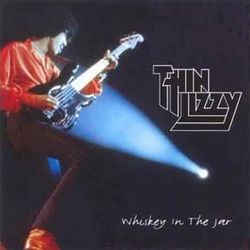

You didn’t mess.”īut there was another side too. On the one hand, as Downey recalls: “Phil was such a tough cookie, a hard man. Heresy.Īlthough he was loath to admit it at the time, fearing, as he said, that people would think of Lizzy as “this electric Irish folk band”, the fact is that Lynott felt a real connection to the song. “When it became a hit I couldn’t believe it, having to go on telly playing it, or miming to it, which I hated.” Further infuriating the band was Decca’s thoughtless misspelling of ‘Whiskey’ – the Irish spelling – on the record sleeve as ‘Whisky’, the English spelling of the golden grain. But it was a joke version, Bell says now, not to be taken seriously. It worked a treat, and Radio 1 finally began playing the song.”īy March it was nestled at No.6 in the UK chart and Lizzy were making their debut appearance on Top Of The Pops.

I peeled off the labels and replaced them with some we’d had made up with ‘Whiskey In The Jar: Thin Lizzy’ on them. “I decided to send these miniature bottles of Whiskey to some of the producers at Radio 1. Until, that is, Carroll had another brainwave. “And a few other ‘specialist DJs’, as they called them, like Kid Jensen and Stuart Henry, loved us, but you would never hear us on the radio in the day.”

“John Peel liked the band and would play us on his show,” Lynott recalled. But despite Decca chopping the track down from five minutes-plus to three-and-a-half by editing out most of Bell’s dappled, Gaelic-lilt guitar solo, it looked like its chances of breaking the band in the UK were slight. It got us out of a jam so we could carry on going as Thin LizzyĪfter that album, a rocked-up version of Whiskey In The Jar represented a massive step forward – at least in terms of profile in Ireland where it reached No.1. “It was an embarrassment,” says a cringing Downey. With Jon Lord-style keyboards by Fudd’s Dave ‘Mojo’ Lennox, and a photo of another band completely on the cover (Hard Stuff, also managed by Carroll), the album Funky Junction Play A Tribute To Deep Purple went on sale in Woolworth in January 1973, priced just 50p. “Phil saw himself as more of a Rod Stewart than an Ian Gillan,” says Downey, “so he did the bass and some backing vocals, and Ted got in Benny White, the singer from another Irish band he managed called Elmer Fudd, who was like a copycat Gillan.” So desperate were the band, in fact, that they had just accepted £1,000 (around ten grand in today’s money) to record an album of Deep Purple covers, under the fictional aegis Funky Junction. Decca wanted Whiskey as the A-side, so we went with it, and the band began playing it live.” Lizzy were really in debt at the time and things were getting desperate. “He’d put so much into Black Boys, seeing it as the band’s first big statement single. “But Eric worked up this fantastic electric guitar version, with that brilliant intro of his, and the first time I heard it I said: ‘This is a hit!’” Decca head honcho Dick Rowe agreed, and unilaterally switched the tracks around, making Whiskey the A-side and Black Boys the B-side. So we put it together a little more solidly.” Ted Carroll heard us fooling around on it and started enthusing about how good it sounded. As Bell recalled in 1973: “We were rehearsing in the Duke Of York pub in King’s Cross in London, and Phil picked up the Telecaster and just began singing Whiskey to his own accompaniment, and I found that little riff which announces the song and runs through it now on the disc.


 0 kommentar(er)
0 kommentar(er)
